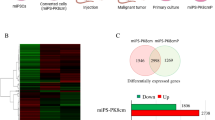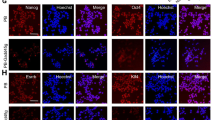Abstract
Several common biological properties between cancer cells and embryonic stem (ES) cells suggest the possibility that some genes expressed in ES cells might have important roles in cancer cell growth. The transcription factor ZFP57 is expressed in self-renewing ES cells and its expression level decreases during ES cell differentiation. This study showed that ZFP57 is involved in the anchorage-independent growth of human fibrosarcoma HT1080 cells in soft agar. ZFP57 overexpression enhanced, whereas knockdown suppressed, HT1080 tumor formation in nude mice. Furthermore, ZFP57 regulates the expression of insulin-like growth factor 2 (IGF2), which has a critical role in ZFP57-induced anchorage-independent growth. ZFP57 also promotes anchorage-independent growth in ES cells and immortal fibroblasts. Finally, immunohistochemical analysis revealed that ZFP57 is overexpressed in human cancer clinical specimens. Taken together, these results suggest that the ES-specific transcription factor ZFP57 is a novel oncogene.
This is a preview of subscription content, access via your institution
Access options
Subscribe to this journal
Receive 50 print issues and online access
$259.00 per year
only $5.18 per issue
Buy this article
- Purchase on Springer Link
- Instant access to full article PDF
Prices may be subject to local taxes which are calculated during checkout







Similar content being viewed by others
References
Evans MJ, Kaufman MH . Establishment in culture of pluripotential cells from mouse embryos. Nature 1981; 292: 154–156.
Martin GR . Isolation of a pluripotent cell line from early mouse embryos cultured in medium conditioned by teratocarcinoma stem cells. Proc Natl Acad Sci USA 1981; 78: 7634–7638.
Smith AG . Embryo-derived stem cells: Of mice and men. Annu Rev Cell Dev Biol 2001; 17: 435–462.
Niwa H . How is pluripotency determined and maintained? Development 2007; 134: 635–646.
Nichols J, Zevnik B, Anastassiadis K, Niwa H, Klewe-Nebenius D, Chambers I et al. Formation of pluripotent stem cells in the mammalian embryo depends on the POU transcription factor Oct4. Cell 1998; 95: 379–391.
Niwa H, Miyazaki J, Smith AG . Quantitative expression of Oct-3/4 defines differentiation, dedifferentiation or self-renewal of ES cells. Nat Genet 2000; 24: 372–376.
Masui S, Nakatake Y, Toyooka Y, Shimosato D, Yagi R, Takahashi K et al. Pluripotency governed by Sox2 via regulation of Oct3/4 expression in mouse embryonic stem cells. Nat Cell Biol 2007; 9: 625–635.
Chambers I, Colby D, Robertson M, Nichols J, Lee S, Tweedie S et al. Functional expression cloning of Nanog, a pluripotency sustaining factor in embryonic stem cells. Cell 2003; 113: 643–655.
Mitsui K, Tokuzawa Y, Itoh H, Segawa K, Murakami M, Takahashi K et al. The homeoprotein Nanog is required for maintenance of pluripotency in mouse epiblast and ES cells. Cell 2003; 113: 631–642.
Chambers I, Silva J, Colby D, Nichols J, Nijmeijer B, Robertson M et al. Nanog safeguards pluripotency and mediates germline development. Nature 2007; 450: 1230–1234.
Boyer LA, Lee TI, Cole MF, Johnstone SE, Levine SS, Zucker JP et al. Core transcriptional regulatory circuitry in human embryonic stem cells. Cell 2005; 122: 947–956.
Loh YH, Wu Q, Chew JL, Vega VB, Zhang W, Chen X et al. The Oct4 and Nanog transcription network regulates pluripotency in mouse embryonic stem cells. Nat Genet 2006; 38: 431–440.
Reya T, Morrison SJ, Clarke MF, Weissman IL . Stem cells, cancer, and cancer stem cells. Nature 2001; 414: 105–111.
Ben-Porath I, Thomson MW, Carey VJ, Ge R, Bell GW, Regev A et al. An embryonic stem cell-like gene expression signature in poorly differentiated aggressive human tumors. Nat Genet 2008; 40: 499–507.
Niwa H, Burdon T, Chambers I, Smith A . Self-renewal of pluripotent embryonic stem cells is mediated via activation of STAT3. Genes Dev 1998; 12: 2048–2060.
Matsuda T, Nakamura T, Nakao K, Arai T, Katsuki M, Heike T et al. STAT3 activation is sufficient to maintain an undifferentiated state of mouse embryonic stem cells. EMBO J 1999; 18: 4261–4269.
Yu H, Jove R . The STATs of cancer—new molecular targets come of age. Nat Rev Cancer 2004; 4: 97–105.
Polakis P . Wnt signaling in cancer. Cold Spring Harb Perspect Biol 2012; 4: a008052.
Sato N, Meijer L, Skaltsounis L, Greengard P, Brivanlou AH . Maintenance of pluripotency in human and mouse embryonic stem cells through activation of Wnt signaling by a pharmacological GSK-3-specific inhibitor. Nat Med 2004; 10: 55–63.
Ogawa K, Nishinakamura R, Iwamatsu Y, Shimosato D, Niwa H . Synergistic action of Wnt and LIF in maintaining pluripotency of mouse ES cells. Biochem Biophys Res Commun 2006; 343: 159–166.
Takao Y, Yokota T, Koide H . β-Catenin up-regulates Nanog expression through interaction with Oct-3/4 in embryonic stem cells. Biochem Biophys Res Commun 2007; 353: 699–705.
Evangelista M, Tian H, de Sauvage FJ . The hedgehog signaling pathway in cancer. Clin Cancer Res 2006; 12: 5924–5928.
Ueda A . Involvement of Gli proteins in undifferentiated state maintenance and proliferation of embryonic stem cells. J Juzen Med Soc 2012; 121: 38–46.
Schoonjans K, Dubuquoy L, Mebis J, Fayard E, Wendling O, Haby C et al. Liver receptor homolog 1 contributes to intestinal tumor formation through effects on cell cycle and inflammation. Proc Natl Acad Sci USA 2005; 102: 2058–2062.
Jeter CR, Badeaux M, Choy G, Chandra D, Patrawala L, Liu C et al. Functional evidence that the self-renewal gene NANOG regulates human tumor development. Stem Cells 2009; 27: 993–1005.
Li X, Ito M, Zhou F, Youngson N, Zuo X, Leder P et al. A maternal-zygotic effect gene, Zfp57, maintains both maternal and paternal imprints. Dev Cell 2008; 15: 547–557.
Quenneville S, Verde G, Corsinotti A, Kapopoulou A, Jakobsson J, Offner S et al. In embryonic stem cells, ZFP57/KAP1 recognize a methylated hexanucleotide to affect chromatin and DNA methylation of imprinting control regions. Mol Cell 2011; 44: 361–372.
Chao W, D'Amore PA . IGF2: epigenetic regulation and role in development and disease. Cytokine Growth Factor Rev 2008; 19: 111–120.
Pollak M . Insulin and insulin-like growth factor signalling in neoplasia. Nat Rev Cancer 2008; 8: 915–928.
Akagi T, Usuda M, Matsuda T, Ko MS, Niwa H, Asano M et al. Identification of Zfp-57 as a downstream molecule of STAT3 and Oct-3/4 in embryonic stem cells. Biochem Biophys Res Commun 2005; 331: 23–30.
Okazaki S, Tanase S, Choudhury BK, Setoyama K, Miura R, Ogawa M et al. A novel nuclear protein with zinc fingers down-regulated during early mammalian cell differentiation. J Biol Chem 1994; 269: 6900–6907.
Alonso MB, Zoidl G, Taveggia C, Bosse F, Zoidl C, Rahman M et al. Identification and characterization of ZFP-57, a novel zinc finger transcription factor in the mammalian peripheral nervous system. J Biol Chem 2004; 279: 25653–25664.
Zuo X, Sheng J, Lau HT, McDonald CM, Andrade M, Cullen DE et al. Zinc finger protein ZFP57 requires its co-factor to recruit DNA methyltransferases and maintains DNA methylation imprint in embryonic stem cells via its transcriptional repression domain. J Biol Chem 2012; 287: 2107–2118.
Mackay DJ, Callaway JL, Marks SM, White HE, Acerini CL, Boonen SE et al. Hypomethylation of multiple imprinted loci in individuals with transient neonatal diabetes is associated with mutations in ZFP57. Nat Genet 2008; 40: 949–951.
Baglivo I, Esposito S, De Cesare L, Sparago A, Anvar Z, Riso V et al. Genetic and epigenetic mutations affect the DNA binding capability of human ZFP57 in transient neonatal diabetes type 1. FEBS Lett 2013; 587: 1474–1481.
Gilmore AP . Anoikis. Cell Death Differ 2005; 12: 1473–1477.
Taddei ML, Giannoni E, Fiaschi T, Chiarugi P . Anoikis: an emerging hallmark in health and diseases. J Pathol 2012; 226: 380–393.
Cifone MA, Fidler IJ . Correlation of patterns of anchorage- independent growth with in vivo behavior of cells from a murine fibrosarcoma. Proc Natl Acad Sci USA 1980; 77: 1039–1043.
Mori S, Chang JT, Andrechek ER, Matsumura N, Baba T, Yao G et al. Anchorage-independent cell growth signature identifies tumors with metastatic potential. Oncogene 2009; 28: 2796–2805.
Samani AA, Yakar S, LeRoith D, Brodt P . The role of the IGF system in cancer growth and metastasis: overview and recent insights. Endocr Rev 2007; 28: 20–47.
Lui JC, Baron J . Evidence that Igf2 down-regulation in postnatal tissues and up-regulation in malignancies is driven by transcription factor E2f3. Proc Natl Acad Sci USA 2013; 110: 6181–6186.
Holm TM, Jackson-Grusby L, Brambrink T, Yamada Y, Rideout WM, Jaenisch R . Global loss of imprinting leads to widespread tumorigenesis in adult mice. Cancer Cell 2005; 8: 275–285.
Jelinic P, Shaw P . Loss of imprinting and cancer. J Pathol 2007; 211: 261–268.
Falix FA, Aronson DC, Lamers WH, Gaemers IC . Possible roles of DLK1 in the Notch pathway during development and disease. Biochim Biophys Acta 2012; 1822: 988–995.
Royo H, Cavaillé J . Non-coding RNAs in imprinted gene clusters. Biol Cell 2008; 100: 149–166.
Huarte M, Rinn JL . Large non-coding RNAs: missing links in cancer? Hum Mol Genet 2010; 19: 152–161.
Farazi TA, Spitzer JI, Morozov P, Tuschl T . miRNAs in human cancer. J Pathol 2011; 223: 102–115.
Takahashi K, Yamanaka S . Induction of pluripotent stem cells from mouse embryonic and adult fibroblast cultures by defined factors. Cell 2006; 126: 663–676.
Yoshida-Koide U, Matsuda T, Saikawa K, Nakanuma Y, Yokota T, Asashima M et al. Involvement of Ras in extraembryonic endoderm differentiation of embryonic stem cells. Biochem Biophys Res Commun 2004; 313: 475–481.
Acknowledgements
We are grateful to Drs Chuanhai Sun and Hitoshi Niwa for providing pCAGPMN(PvuII-MfeI)-CreER and pBRPyCAG-fKlf4-DsRed-IP, respectively. We also thank the Center for Biomedical Research and Education at Kanazawa University for the use of their DNA sequencer. This work was partly supported by Grants-in-Aid for Scientific Research from the Ministry of Education, Culture, Sports, Science and Technology of Japan, a grant from the Hokkoku Foundation for Cancer Research and an Extramural Collaborative Research Grant from the Cancer Research Institute, Kanazawa University.
Author information
Authors and Affiliations
Corresponding author
Ethics declarations
Competing interests
The authors declare no conflict of interest.
Additional information
Supplementary Information accompanies this paper on the Oncogene website
Supplementary information
Rights and permissions
About this article
Cite this article
Tada, Y., Yamaguchi, Y., Kinjo, T. et al. The stem cell transcription factor ZFP57 induces IGF2 expression to promote anchorage-independent growth in cancer cells. Oncogene 34, 752–760 (2015). https://doi.org/10.1038/onc.2013.599
Received:
Revised:
Accepted:
Published:
Issue Date:
DOI: https://doi.org/10.1038/onc.2013.599
Keywords
This article is cited by
-
ZNF37A promotes tumor metastasis through transcriptional control of THSD4/TGF-β axis in colorectal cancer
Oncogene (2021)
-
Critical role of SOX2–IGF2 signaling in aggressiveness of bladder cancer
Scientific Reports (2020)
-
Platelet-derived growth factor-C functions as a growth factor in mouse embryonic stem cells and human fibrosarcoma cells
Cellular & Molecular Biology Letters (2018)
-
Essential role of insulin-like growth factor 2 in resistance to histone deacetylase inhibitors
Oncogene (2016)
-
Carcinoma of the colon and rectum with deregulation of insulin-like growth factor 2 signaling: clinical and molecular implications
Journal of Gastroenterology (2016)



